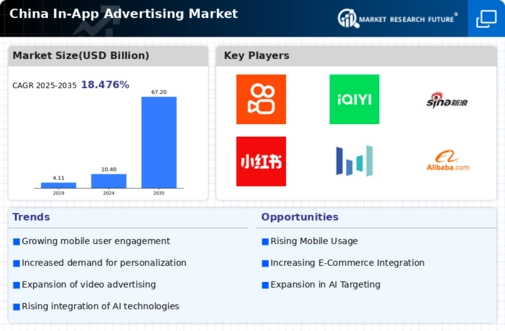Evolving Consumer Behavior
Consumer behavior in China is rapidly evolving, significantly impacting the in app-advertising market. With a growing preference for mobile applications over traditional media, users are increasingly engaging with apps for entertainment, shopping, and social interaction. This shift is reflected in the fact that mobile app usage has surged by over 30% in recent years. As consumers spend more time on apps, advertisers are compelled to adapt their strategies to capture this attention. The demand for relevant and engaging content is paramount, leading to a rise in personalized advertising efforts. Consequently, the in app-advertising market is likely to see a transformation in how brands connect with users, focusing on delivering tailored experiences that resonate with individual preferences.
Rising Smartphone Penetration
The in app-advertising market in China is experiencing a notable surge due to the increasing penetration of smartphones. As of 2025, approximately 1.2 billion mobile users are active in China, with smartphone ownership reaching around 90%. This widespread adoption facilitates greater access to mobile applications, thereby expanding the audience for in app-advertising. The growing number of mobile users indicates a potential for advertisers to reach a larger demographic, enhancing the effectiveness of their campaigns. Furthermore, the shift towards mobile-first strategies among businesses suggests that the in app-advertising market will continue to thrive as more companies allocate budgets towards mobile advertising. This trend is likely to drive innovation in ad formats and targeting strategies, ultimately benefiting the overall industry.
Growth of E-commerce Integration
The integration of e-commerce within mobile applications is significantly driving the in app-advertising market in China. As online shopping continues to gain traction, with e-commerce sales projected to reach over $2 trillion by 2025, advertisers are increasingly leveraging in app-advertising to promote products directly within apps. This trend allows for seamless shopping experiences, where users can discover and purchase products without leaving the application. The rise of social commerce, where social media platforms incorporate shopping features, further enhances this integration. Consequently, brands are investing more in app-advertising to capitalize on this trend, leading to a dynamic shift in advertising strategies. The in app-advertising market is likely to benefit from this growth, as advertisers seek to create engaging and interactive shopping experiences for consumers.
Regulatory Changes and Compliance
The regulatory environment in China is evolving, impacting the in app-advertising market significantly. Recent changes in data privacy laws and advertising regulations necessitate that companies adapt their practices to ensure compliance. As of November 2025, stricter guidelines are in place regarding user consent and data usage, which could influence how advertisers collect and utilize consumer information. This shift may lead to increased transparency in advertising practices, fostering trust among users. While compliance may pose challenges for some advertisers, it also presents an opportunity for those who can navigate the regulatory landscape effectively. The in app-advertising market is likely to see a rise in demand for solutions that prioritize user privacy while still delivering effective advertising outcomes.
Technological Advancements in Advertising
Technological advancements are playing a crucial role in shaping the in app-advertising market in China. Innovations such as artificial intelligence (AI) and machine learning are enabling advertisers to analyze user data more effectively, leading to improved targeting and personalization. As of 2025, it is estimated that AI-driven advertising solutions could account for nearly 40% of the total ad spend in the in app-advertising market. These technologies allow for real-time adjustments to campaigns, optimizing performance and enhancing user engagement. Moreover, the integration of augmented reality (AR) and virtual reality (VR) into advertising strategies is emerging, providing immersive experiences that captivate users. This technological evolution is likely to redefine the landscape of the in app-advertising market, fostering creativity and innovation.

















Leave a Comment